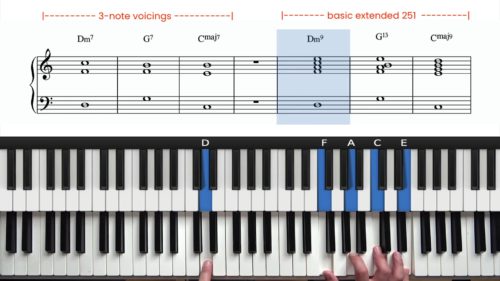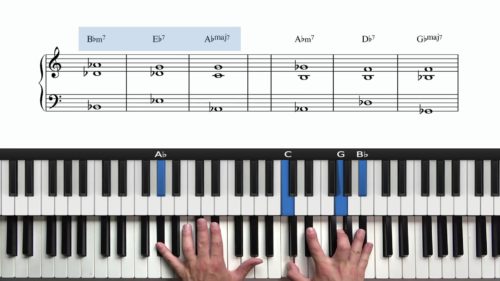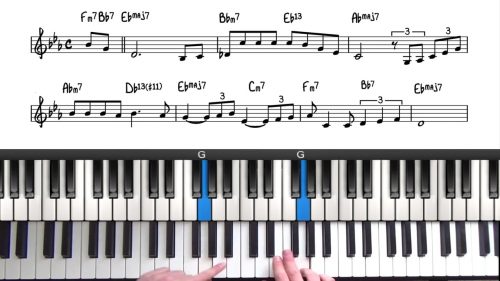Shell Voicings For Jazz Piano
In this lesson we will apply shell voicings to the tune “The Nearness Of You”. We will also incorporate arpeggio left hand patterns to add variety to the basic shell voicings used in our left.
What Are Shell Voicings?
Shell voicings are the most basic form voicings when playing jazz. Shell voicings typically contain just the essential chord tones which are the root, the 3rd, and the 7th of the chord. Shell voicings help us spread the notes of the chord over an octave so that we achieve a more balanced sound from the piano.
Usually we play the root and 7th of the chord in our left hand, and the 3rd of the chord in our right hand. See the following example:
Vice-versa we can play the root and 3rd in our left hand and the 7th of the chord in our right hand. However, start by playing root and 7th in the left hand as in the example above.
Arpeggio Left Hand Patterns
To add more movement and interest into our left hand, we can arpeggiate the notes of the chord. We can arpeggiate the basic triad as seen over the Fmaj7 and Cmin7 chords below. We can also arpeggiate up to the 7th of the chord and mix this left hand style with shell voicings to create variety in our left hand.
Practice both shell voicings and arpeggiating the notes in our left hand.
251 Progression With Shell Voicings
It’s important for new jazz piano students to be able to construct shell voicings and clearly visualise the 7ths falling to 3rds in the major 251 progression.
Learn Through Application
In the past lessons we practiced the 251 progression with 3-note voicings. We are now going to use the exact same notes and also play the melody in our right hand. The golden formula that we need to remember when playing from lead sheets is:
- Bass note in our left hand
- Melody in our right hand
- 3rd and 7th of the chord in between with either hand
Adding Chords Extensions Into Our Voicings
In the next course on jazz piano chord extensions we learn to add additional notes into our basic shell voicings to achieve a richer and jazzier sound.
Practice Tips
-
Shell voicings are perfect for outlining the harmony as they just contain the essential chord tones 1-3-7.
-
When playing tunes with shell voicings, be sure to visualise the 7ths falling to 3rd in the 25s and 251 progressions.
-
Alternating shell voicings and left hand arpeggios creates more interest and movement in the left hand.
-
Once you are comfortable with the concept of shell voicings we can start to add chord extensions into our voicings.








Great session. I have been working at this for some time, and I just discovered the transcription. I had been missing the cadence of the arpeggiated chord notes (and completely missed some of the notes as you move much faster than me!) Thanks for that. It speeds up the learning and I am now going back over the song to see how the theory fits together and where extensions might be added. I would see some of it, but other parts were well off in the distance. Still working on the basics, and your explanations of the theory are mind-expanding and help with understanding the whys and hows. Thanks, Hayden!
Hi Ron,
I’m glad you enjoyed the lesson.
Whilst working on the basics I recommend that all new students ‘get their toes’ wet in some of the more advanced theory.
I talk about this in detail in this seminar: https://www.pianogroove.com/live-seminars/jazz-voicings-for-beginners/
The basics take time to fully master and so we can start to expand our knowledge of chord extensions and other early-intermediate jazz topics.
Take a look overt the seminar above and also download the PDF handout which has links to lots of different drills and exercises that you can work on. Here is the PDF handout:
https://www.pianogroove.com/wp-content/uploads/2022/01/Voicings-For-Beginners-Beyond.pdf
Cheers, Hayden
Hi! I absolutely love your arrangements of jazz standards. However I am having a hard time remembering the voicings. After I practise with the video I know most of it, but as soon as I move on to another jazz standard all voicings that made the first one beautiful have been vanished from my brain. And I am back to playing the chords I see on the lead sheet in a somewhat simple way that I can easily visualize, or just hit something ‘in that key’ hoping to touch a nice extension by accident. When the voicing has a name such as Kenny Barron I can annotate my lead sheet, but this doesn’t count for most.
What is the best way to work from here? Annotate more efficiently (by giving every voicing a made-up name)? Or work towards top-speed visualisation of every ‘number’ in every key, so that I can be creative on the go? Probably in ten years… but what best to do in the meantime?
Hi Stella,
Good question here and the answer is quite lengthy, here we go…
Firstly it is very natural to find it difficult to memorise jazz standards when just starting out, so don’t worry about that.
I recommend that all new students aim to learn 10 to 20 jazz standards as a priority so that you are exposed to lots of different harmonies and melodies. Whilst doing this you may well forget the earliest tunes that you learnt but you can come back to these later on.
I recommend first to work on expanding your repertoire as mentioned above, and whilst doing this you will find that some tunes will resonate more with you than others, and so add these into a ‘short list’ of tunes that you personally really like.
With your short list it’s a good idea to spend more time to memorise the chord changes. For example we can actually break this tune (Nearness Of You) down into smaller pieces of information so that it is easier to remember, I cover this breakdown in the following live seminar where we discuss the form of the tune and we also group together blocks of harmony to make it easier to remember.
Check out the seminar here: https://www.pianogroove.com/live-seminars/nearness-of-you-solo/
It’s important to note that I have been playing this tune for many years, and as each year passes we gain a deeper understanding of the tunes we are playing and ultimately we can continue to develop and enhance our arrangements for the rest of our lives, so it is very much an ongoing process.
In terms of memorisation tips, check out the following lesson: https://www.pianogroove.com/jazz-piano-lessons/common-jazz-forms/
Here is an important point relating to visualising voicings:
Always analyse the melody note in terms of scale degrees in relation to the underlying chord. When you keep doing this over and over, your brain and your hands will start to instinctively gravitate towards certain voicings when you are reading lead sheets.
There is not an infinite number of notes that we can play over a given chord and so the task is much easier than you think. Every time that you play a chord voicing that you like, stop to analyse the melody note in terms of scale degrees and then memorise that voicing so that you can use it in other keys. If a specific voicing sounds good for a C Major 9 chord, the same voicing will sound good for the other 11 keys, and so we must memorise the construction of the voicing in terms of numerical scale degrees so that we have the ‘blueprint’ to transpose to the other keys and apply in other songs and tunes.
For example if we have a major chord with the 9 in the melody, we must have memorised the formula for a selection of voicings that we know will work in that situation, and then do the same for major/minor/dominant chords as you are working through the jazz standard arrangements.
The main task you have is just working through many jazz standards and everything will make sense with time Stella.
For notating/annotating lead sheets, check out the 6th chapter of this seminar: https://www.pianogroove.com/live-seminars/beginner-jazz-qa-session/ the chapter is entitled “Creating Fills & Arranging Tunes” – you will see that I recommend to just write the chord colours and tensions.
Finally, here are a series of lessons which will help you to learn more voicings:
https://www.pianogroove.com/jazz-piano-lessons/major-voicing-variations/ https://www.pianogroove.com/jazz-piano-lessons/minor-voicing-options/ https://www.pianogroove.com/jazz-piano-lessons/dominant-chord-voicings-part-1/
I hope that helps Stella. Check out the videos referenced above and let me know if you have any further questions.
Cheers, Hayden
Very helpful, thanks!!
What’s the difference between spread voicing, 3 note voicing and shell voicing?
Hi Alex,
Great question and apologies for the late reply here.
These 3 terms are similar but also slightly different. In essence, they all refer to a simple voicing construction that is used to outline the most important tones of the chord.
Here are the more elaborated definitions:
Spread Voicing – A spread voicing is when we take the notes of a closed position voicing (closed position means that the notes of the voicing do not extend past 1 octave) and then we spread the notes out over more than an octave, usually 2 octaves. This creates a more balanced sound. An example would be to take a root position Fmaj7 which would be F-A-C-E and then play the root in our left hand down in the lower registers of the piano, and play the 3rd and 7th in the middle of the piano, and then the melody note on top, similar to the first voicing for this tune “The Nearness Of You”.
3-Note Voicing – a 3-note voicing is a voicing containing just the root, the 3rd, the 7th, and then the melody on top. The most important notes of any voicing are the 3rd and 7th as these tones define the harmonic quality of the chord ie. is it major, minor, dominant etc… In the later lessons we introduce other notes such as chord extensions (9s, 11s, 13s) to create jazzier sounds, but in this course we focus on 3-note voicings to get a good understanding of the basics of the harmony and how 7ths fall to 3rds in the 251 progressions.
Shell Voicings – A common shell voicing is to play the root and 7th in the left hand. See the attached graphic where I have highlighted the shells in red. Shells are useful to outline the “shell” of the harmony in the left hand, and then the right hand plays the rest of the chord. Shell voicings can also be root and 3rd, or even root, 3rd, and 7th, all played in the left hand. But for now just see the shells as root and 7 in the left hand as illustrated in the graphic attached to this comment.
I hope that helps Alex and let me know if you have any further questions.
Cheers, Hayden
Hello…this is whitney…LOVING IT SO FAR!!!!!!!!
Hey Whitney 👋
I’m glad to hear that you are enjoying the lessons.
I recommend that new students study the following 2 jazz standard courses:
https://www.pianogroove.com/jazz-piano-lessons/cocktail-improvisation-for-beginners/ https://www.pianogroove.com/jazz-piano-lessons/bluesy-stride-piano-beginners/
In these courses we cover the tunes “Misty” and “Georgia On My Mind” and we approach them in a step-by-step format which will help you to understand how to read lead sheets and create beautiful jazzy arrangements.
Enjoy the lessons and keep me posted on your progress :–)
Cheers, Hayden
Hello ok ill do that
Another enjoyable lesson Hayden – thanks!
I have a university degree in jazz piano and I found it intimidating – looking back I think it was that I was learning the advanced information from the start
So, trying to create a ‘hip’ arrangement right away
I’m really enjoying this as a piano player – as a stepping stone to get back into it
And also, as a piano teacher – I walk away from these lessons and they’re so fun, and so clear, that I show my students in the evening what’ I’ve been up to that afternoon – it’s so fun,
and I love the way you’re playing, and also the way you’re teaching the material and keeping it at this level
I appreciate it!
Thanks for the comment Megan.
You might like to check out my 2 newest courses which use this tune, and the tune “Misty” check out the courses here:
“Misty” – Cocktail Piano Improvisation: https://www.pianogroove.com/jazz-piano-lessons/cocktail-improvisation-for-beginners/
“Nearness Of You”: Ballad Fills & Runs: https://www.pianogroove.com/jazz-piano-lessons/ballad-voicings-fills-improv/
In these 2 courses we start with the most basic arrangement techniques and gradually layer in more complexity as the lessons progress.
The idea is that these courses can accommodate for beginners whilst also pushing new jazz students to ‘get their toes wet’ with some more advanced voicings styles and principles. There has been some great feedback on these courses so far.
I think it’s also nice to individually break down the different options that are available to us, instead of immediately teaching a set arrangement full of advanced techniques and principles.
With the step-by-step approach of these new courses, the student can always ‘fall back’ onto the basic R-3-7 version, and slowly introduce the more advanced elements as they feel more comfortable. These tunes are expertly composed and so they do sound beautiful with just simple R-3-7 voicings!
Talk soon, Hayden
Hi, I’ve studied with a jazz teacher in the past and I learned spread voicings as numbers, Spread 1 is the 1,5 in left hand 3,7 in right Spread 2 is the 1,5,7 in left the 3 in right Spread 3 is 1,7 in left 3,5 right Spread 4 is 5,1,3 in left 7 right Spread 5 is 1;5,7 in left 3,5 right Spread 6 is 3,1 in left 5,7 right Spread 7 is 7,3,5 in left 1 in right I play them going around the circle of 5ths When I learn a piece in the fake book I write the Spread numbers above each chord to help me learn and experiment which voicing sounds best and has less hand movements. I’m still at the early stages so it also helps to write the notes next to the spread voicing number and because I’m more classically trained the notes are still a bit of a needed crutch.Make sense? Best Eric
Hi Eric 👋
Yes thinking of shell voicings/spread voicings in terms of numbers is the correct approach.
Whether we choose to play 1-3, 1-7, 1-5-7, 1-3-7 etc… is usually dependent on the melody note. Often the melody note is one of the chord tones (3, 5, or 7) and so this can inform our choice of left hand shell voicing.
Writing the numbers next to the notes on the lead sheet or transcription can be useful when starting out, and with time this process becomes second nature; we see the chord symbol and the melody note and our hands gravitate to the voicing shapes.
The best way to improve at this is from playing lots of tunes. Once you have worked through 10 or so tunes using spread voicings you will be much more comfortable with the process. I recommend to avoid over-reliance on transcriptions so make sure that you are visualising the 3rds and 7ths on the piano.
Complete this 3-note 251 drill on a daily basis to help with visualising the chords tones and voice leading of 7ths dropping to 3rds: https://www.pianogroove.com/jazz-piano-lessons/251-progression-with-3-note-voicings/
Once you are more comfortable with the 3-note 251s in all 12 keys, you can move onto the next drill which is 251s with extended chord voicings. https://www.pianogroove.com/jazz-piano-lessons/extended-251-progression-drill/
I demonstrate and explain these 2 progressions in the seminar “Essential Chord Progressions”: https://www.pianogroove.com/live-seminars/chord-progressions-for-beginners/
Talk soon, Hayden
Do you have a suggested list of jazz standards for a beginner to start working on? You recommend 10 to 20 as a good number to aim at. Suggestions for what those might be?
Hi Francis,
Yes I recently added a new “Novice” section to the jazz piano lessons index, you can see it here: https://www.pianogroove.com/jazz-piano-lessons/ (the green tab on the left titled “Novice”)
This new Novice section is designed for beginner students to quickly build out their repertoire with simple R-3-7 arrangements, currently there are 6 tunes in this section broken down into step-by-step tutorials, and more are coming shortly.
Also, all of the jazz standards are indexed by difficulty here: https://www.pianogroove.com/jazz-standard-index-difficulty/
I recommend to start with the “Novice” category, and then the “Beginner” category lessons.
Here are some Beginner jazz standards that I would recommend for you:
The Nearness Of You (this lesson page)
Pure Imagination: https://www.pianogroove.com/jazz-piano-lessons/nearness-of-you-for-beginners/
The Days Of Wine & Roses: https://www.pianogroove.com/jazz-piano-lessons/days-of-wine-roses-for-beginners/
I am shortly adding a new page to the Pro Dashboard which is called “Start Here” and this page will contain a few videos which explain where to start on the website if you are a beginner and/or new to PianoGroove. The new page should be ready in the coming days so keep an eye out for it.
In the interim, take a look over the links above and let me know if you have any more questions.
Talk soon, Hayden